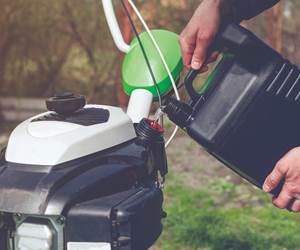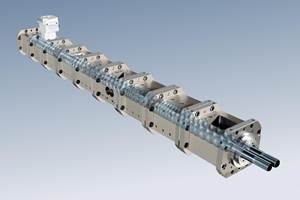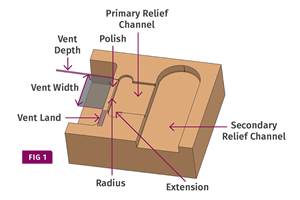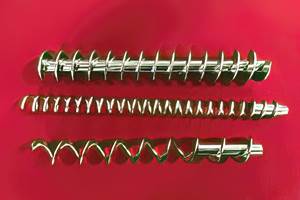The Truth About Barrel Heating
The main purposes of the heaters are to melt the polymer that remains in the barrel at cold startup, to assist in forming the initial melt, and to “trim” the barrel temperatures for specific purposes such as improving feed rate.
Barrel heaters have very little impact on melting, an aspect of polymer processing that is misunderstood by quite a few. I recently discussed processing with someone who has been in extrusion for almost 30 years, and he asked me if he would need greater wattage-capacity heaters for more output. Even he did not understand that most melting occurs through shear heating and is the result of the drive power being converted to heat via the screw.
The main purposes of the heaters are to melt the polymer that remains in the barrel at cold startup, to assist in forming the initial melt, and to “trim” the barrel temperatures for specific purposes such as improving feed rate.
Typical barrel-heating capacities are based on watts/in.² of barrel outside surface area, and they have little relationship to extruder output. The typical values used are 25-35 W/in.², depending on how quickly the extruder manufacturer wants to be able to reach startup temperatures. Smaller extruders have more barrel-heating capacity than larger ones because they have more barrel surface area in relation to their output.
There is a practical limit to how much wattage to put on the barrel. Too much wattage will tend to upset the desirable steady-state principle that’s critical to most extrusion operations by imposing an overwhelming heat flux. Also, excessive wattage can cause the polymer near the barrel wall to burn before the material down in the screw flights becomes fully heated.
The shear-heating energy that comes from the drive is similar to stirring a very viscous fluid rapidly with a paddle. It’s going to take a lot of muscle and energy on the part of the person stirring. Where does all that energy go? It’s converted to heat in the fluid and is termed “viscous dissipation.” To visualize this, think of bending a wire back and forth until it breaks. The area near the break will be hot because the mechanical energy used to break it ended up as heat in the wire. The more viscous the fluid the more energy it takes to stir it and the more heat that will be generated.
It’s the same in extrusion: The more viscous the polymer, the more energy it takes to turn the screw, resulting in more heat being transferred to the polymer. That’s one of the main reasons that different polymers require different screw designs and different amounts of drive power. It’s also why melt temperatures are different for different polymers. For example a 2.0 MI polyethylene is going to have a lower melt temperature than a 0.2 MI PE with the same conditions and same screw because of viscous dissipation. Finally, consider that the viscosity of some polymers is reduced significantly with increasing shear stress. That accounts for the more rapid rise in melt temperature with screw speed for a polymer that does not significantly “shear thin” than for one that does.
The most effective adjustment the screw designer has to control melt temperature is specific output or output per screw revolution. Essentially the less overall stirring and the less stirring time the polymer experiences, the lower the melt temperature. That explains, for example, why a long L/D extruder is not suitable for low output levels. However the screw designer always has to work within the limits of the available extruder, its drive power (torque), and a usable melt condition with no unmelt. This sometimes makes it impossible to obtain the desired result on every extruder.
Related Content
Polyethylene Fundamentals – Part 4: Failed HDPE Case Study
Injection molders of small fuel tanks learned the hard way that a very small difference in density — 0.6% — could make a large difference in PE stress-crack resistance.
Read MoreHow to Configure Your Twin-Screw Barrel Layout
In twin-screw compounding, most engineers recognize the benefits of being able to configure screw elements. Here’s what you need to know about sequencing barrel sections.
Read MoreBack to Basics on Mold Venting (Part 2: Shape, Dimensions, Details)
Here’s how to get the most out of your stationary mold vents.
Read MoreWhat to Know About Your Materials When Choosing a Feeder
Feeder performance is crucial to operating extrusion and compounding lines. And consistent, reliable feeding depends in large part on selecting a feeder compatible with the materials and additives you intend to process. Follow these tips to analyze your feeder requirements.
Read MoreRead Next
People 4.0 – How to Get Buy-In from Your Staff for Industry 4.0 Systems
Implementing a production monitoring system as the foundation of a ‘smart factory’ is about integrating people with new technology as much as it is about integrating machines and computers. Here are tips from a company that has gone through the process.
Read MoreLead the Conversation, Change the Conversation
Coverage of single-use plastics can be both misleading and demoralizing. Here are 10 tips for changing the perception of the plastics industry at your company and in your community.
Read MoreMaking the Circular Economy a Reality
Driven by brand owner demands and new worldwide legislation, the entire supply chain is working toward the shift to circularity, with some evidence the circular economy has already begun.
Read More.jpg;width=70;height=70;mode=crop)












